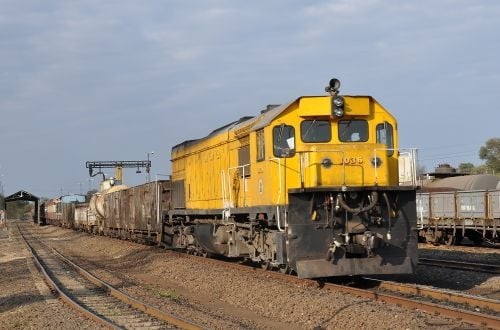
ZIMBABWE has embarked on an ambitious initiative to breathe new life into its aging railway network, forging a strategic alliance with the China Railway Group Ltd.
This collaboration, valued at a staggering US$533 million, aims to leverage China's expertise and financial prowess to modernise the country's rail infrastructure from the ground up.
The impetus behind this endeavour stems from Zimbabwe's pressing need to bridge the widening gap with its regional counterparts, such as Mozambique and Zambia, which have outpaced the nation in terms of railway development.
By joining forces with a global leader in infrastructure projects, Zimbabwe seeks to regain its competitive edge and position itself as a formidable player in the realm of logistics and transportation.
The scope of this revitalisation project is comprehensive, encompassing both the fixed and rolling components of Zimbabwe's rail network.
From rehabilitating tracks and signalling systems to acquiring new locomotives and refurbishing existing rolling stock, no stone will be left unturned in the pursuit of operational efficiency and safety, at least according to the government.
Finance, Economic Development and Investment Promotion minister Mthuli Ncube, a driving force behind this initiative, expressed confidence in China's capabilities, stating, “We believe that we could make use of their expertise and financial muscle to improve the National Railways of Zimbabwe (NRZ).”
This sentiment seemingly underscores the government's determination to leverage the partnership to its fullest potential, ushering in a new era of rail transportation for the nation.
- Mavhunga puts DeMbare into Chibuku quarterfinals
- Bulls to charge into Zimbabwe gold stocks
- Ndiraya concerned as goals dry up
- Letters: How solar power is transforming African farms
Keep Reading
For years, Zimbabwe has lagged behind its neighbouring nations in terms of railway infrastructure development. This disparity has not only hindered the country's economic growth but also limited its ability to capitalise on its abundant natural resources, including lithium, coal, chrome, and granite, which are primarily destined for export to Asian markets, particularly China.
By addressing this infrastructure deficit, Zimbabwe aims to regain its competitive edge and unlock new opportunities for trade and commerce.
The revitalised rail network will facilitate the efficient transportation of goods, reducing transportation costs and enhancing the nation's attractiveness as a hub for mineral exports.
Zimbabwe's mineral wealth has long been a cornerstone of its economy, yet the lack of an efficient transportation system has hindered its ability to fully capitalise on this resource.
With the revamped rail network, the country will be better equipped to meet the growing demand for its mineral exports in Asian markets, particularly China.
By streamlining the transportation of these valuable commodities, Zimbabwe can enhance its export revenues, bolster its economic growth, and strengthen its position as a reliable supplier in the global mineral trade.
To formalise this transformative partnership, a memorandum of understanding has been signed between the National Railways of Zimbabwe (NRZ) and China Railway Group Ltd. This milestone marks the initiation of the project and sets the stage for a comprehensive feasibility study to be conducted by the end of June.
During this crucial phase, Chinese experts will meticulously assess the current state of Zimbabwe's rail infrastructure, including locomotives, wagons, and workshops.
Their findings will inform the scope of work required, the estimated costs, and the projected timeline for completion. The results of the feasibility study will play a pivotal role in shaping the final agreement between the two parties.
Zimbabwe and China have set their sights on formally unveiling this landmark deal during the upcoming Forum for China and Africa, scheduled for August and September.
This timing underscores the significance of the project not only for Zimbabwe but also for the broader China-Africa relationship. Despite its rich mineral resources and strategic location, Zimbabwe's rail industry has experienced a steady decline in recent years.
The National Railways of Zimbabwe (NRZ) has grappled with dwindling freight volumes, with current levels hovering around three million tonnes annually, a stark contrast to the peak of five million tons witnessed in the past.
This downward trend has not only impacted the country's economic prospects but has also highlighted the urgency of revitalising the rail sector.
Beyond its domestic impact, the revitalisation of Zimbabwe's rail network holds significant implications for regional connectivity and integration.
As a strategic transportation hub, a modernised rail system in Zimbabwe will facilitate the seamless movement of goods and resources across borders, fostering stronger economic ties with neighbouring nations.
This enhanced connectivity will not only benefit Zimbabwe but will also contribute to the broader development goals of the region, promoting trade, investment, and economic cooperation among African nations.
The Zimbabwe-China rail partnership aligns with various regional development initiatives aimed at enhancing infrastructure and promoting economic integration.
Initiatives such as the African Union's Agenda 2063 and the Southern African Development Community (Sadc) Regional Infrastructure Development Master Plan emphasise the pivotal role of efficient transportation networks in driving sustainable growth and development.
The revitalisation of Zimbabwe's rail network extends far beyond the realm of transportation; it holds the potential to catalyse broader economic transformation and unlock new opportunities for growth and development.
Efficient rail infrastructure is a critical enabler for various sectors, including agriculture, manufacturing, and mining, facilitating the movement of raw materials, finished goods, and equipment.
By addressing this bottleneck, the Zimbabwe-China partnership paves the way for increased productivity, reduced operational costs, and enhanced competitiveness across multiple industries.
A modernized rail network not only enhances the movement of goods but also serves as a powerful magnet for foreign investment. Investors seek reliable and efficient transportation systems to support their operations, and Zimbabwe's revitalised rail infrastructure will position the country as an attractive destination for capital inflows.
Furthermore, the rehabilitation project itself will generate numerous employment opportunities, both directly through construction and maintenance activities and indirectly through the stimulation of ancillary industries and services.
This influx of jobs will contribute to economic empowerment, skill development, and improved livelihoods for Zimbabweans. The Zimbabwe-China rail partnership extends beyond mere infrastructure development; it represents a significant milestone in the strengthening of bilateral ties between the two nations.
China's involvement in this project is a testament to its continued investment in regional infrastructure initiatives across the African continent.
By leveraging its expertise and financial resources, China is solidifying its position as a trusted partner in driving development and fostering economic integration within the region.
Beyond the physical infrastructure upgrades, the partnership also presents an opportunity for knowledge transfer and capacity building. Chinese experts will work closely with their Zimbabwean counterparts, sharing best practices, technical know-how, and innovative approaches to rail infrastructure management and operations.
This exchange of knowledge and skills will empower local professionals, enabling them to take owner- ship of the revitalized rail network and ensure its long-term sustainability.
It will also foster a culture of continuous improvement and innovation, positioning Zimbabwe as a regional leader in rail transportation.
The partnership can leverage cutting-edge green technologies and best practices to ensure the revitalised rail network operates in an environmentally responsible manner.
This could include the adoption of energy-efficient locomotives, the implementation of sustainable maintenance practices, and the incorporation of renewable energy sources to power rail operations. Operational efficiency and safety are paramount considerations in the revitalisation of Zimbabwe's rail network.
The partnership with China presents an opportunity to implement state-of-the-art technologies and best practices to optimise rail operations and ensure the highest standards of safety for both passengers and cargo.
The integration of advanced technologies, such as automated signalling systems, real-time tracking, and predictive maintenance solutions, will play a pivotal role in enhancing operational efficiency and safety.
These cutting-edge systems will enable better coordination, improved asset management, and proactive maintenance, reducing the risk of accidents and minimizing disruptions to rail services.
Additionally, the procurement of modern rolling stock equipped with advanced safety features will further bolster the overall safety profile of Zimbabwe's rail network, instilling confidence in both domestic and international stakeholders.
The rail partnership also aligns with various regional trade agreements and initiatives aimed at promoting economic integration and facilitating cross-border trade. Initiatives such as the African Continental Free Trade Area (AfCFTA) and the Sadc Free Trade Area emphasize the importance of efficient transportation networks in fostering intra-regional trade and economic cooperation.
By investing in its rail infrastructure, Zimbabwe is positioning itself as a strategic hub for regional trade, facilitating the movement of goods and resources across borders and contributing to the realisation of shared economic goals.
- Equity Axis is a financial media firm offering business intelligence, economic and equity research. The article was first published in its latest weekly newsletter, The Axis.











